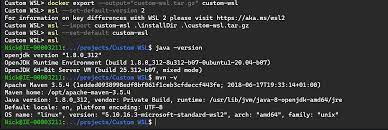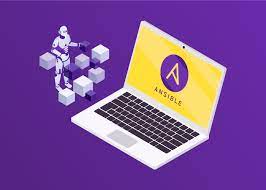Optimizing Docker: Exploring the Benefits of a Minimal Linux Distro
Minimal Linux Distro for Docker
In the world of containerization, Docker has revolutionized the way applications are developed, deployed, and scaled. With its lightweight and portable nature, Docker allows developers to package their applications along with their dependencies into containers that can run on any platform.
When it comes to running Docker containers efficiently, choosing the right Linux distribution is crucial. While there are numerous options available, a minimal Linux distribution specifically tailored for Docker can provide several advantages.
What is a Minimal Linux Distro?
A minimal Linux distribution is one that includes only the essential components required to run an operating system. It strips away unnecessary packages and libraries, resulting in a smaller footprint and reduced resource consumption.
The Benefits of Using a Minimal Linux Distro for Docker
Improved Performance:
A minimal Linux distro eliminates bloatware and focuses on providing just what is needed to run Docker containers. This streamlined approach leads to improved performance by reducing overhead and maximizing resource utilization.
Enhanced Security:
By minimizing the attack surface, a minimal Linux distro reduces the potential vulnerabilities that can be exploited by malicious actors. With fewer components installed, there are fewer potential entry points for attacks.
Faster Deployment:
A smaller image size means faster deployment times for your Docker containers. With less data to transfer, you can spin up new instances more quickly and scale your applications faster.
Simplified Maintenance:
With fewer packages to manage, maintaining a minimal Linux distro becomes easier. Updates and security patches can be applied more efficiently, reducing the risk of compatibility issues and minimizing downtime.
Popular Minimal Linux Distros for Docker
There are several minimal Linux distributions that are widely used for running Docker containers. Here are a few notable examples:
- Alpine Linux: Known for its small size and security-focused design, Alpine Linux is a popular choice for Docker deployments. It boasts a minimalistic approach while still providing a functional environment.
- CoreOS Container Linux: Designed with containerization in mind, CoreOS Container Linux offers automatic updates, easy management, and strong security features. It is built to run on large-scale deployments.
- RancherOS: Built specifically for running containers, RancherOS comes with a minimalist design and focuses on simplicity. It provides a lightweight environment optimized for Docker.
Conclusion
A minimal Linux distro tailored for Docker brings numerous benefits to your containerized applications. With improved performance, enhanced security, faster deployment times, and simplified maintenance, you can optimize your Docker workflow and ensure efficient utilization of resources.
When choosing a minimal Linux distro for Docker, consider factors such as image size, security features, ease of management, and community support. Evaluate your specific requirements to find the best fit that aligns with your needs.
Maximising Docker Efficiency: The Advantages of Minimalist Linux Distributions
- 1. Improved Performance
- 2. Enhanced Security
- 3. Faster Deployment
- 4. Simplified Maintenance
- 5. Efficient Resource Utilization
Seven Drawbacks of Using Minimalist Linux Distributions for Docker Environments
- Limited Package Availability
- Steeper Learning Curve
- Potential Compatibility Issues
- Reduced User-Friendly Features
- Limited Hardware Support
- Less Community Support
- Lack of Preinstalled Software Packages
1. Improved Performance
One significant advantage of using a minimal Linux distro for Docker is the improved performance it offers. By eliminating unnecessary components and focusing only on what is essential, a minimal Linux distro reduces overhead and maximizes resource utilization. This streamlined approach ensures that Docker containers run more efficiently, leading to enhanced performance and faster execution of applications. With fewer system resources being consumed, developers can make the most out of their hardware and achieve optimal performance for their containerized environments.
2. Enhanced Security
One of the significant advantages of using a minimal Linux distro for Docker is the enhanced security it offers. By reducing the attack surface and eliminating unnecessary components, a minimal Linux distro creates a more secure environment for running Docker containers. With fewer potential vulnerabilities, the risk of exploitation by malicious actors is significantly reduced. This heightened security ensures that your containerized applications are well-protected, giving you peace of mind as you deploy and manage your Docker infrastructure.
3. Faster Deployment
One significant advantage of using a minimal Linux distro for Docker is faster deployment. By reducing the image sizes, the process of deploying Docker containers becomes quicker and more efficient. With less data to transfer, spinning up new instances and scaling applications can be done at a much faster pace. This not only saves time but also enables seamless scalability, ensuring that your applications can handle increased workloads without unnecessary delays.
4. Simplified Maintenance
One significant advantage of using a minimal Linux distro for Docker is simplified maintenance. With fewer packages to update and maintain, managing the operating system becomes much easier. This streamlined approach reduces the risk of compatibility issues and minimizes downtime. By focusing on essential components only, a minimal Linux distro allows for efficient updates and security patches, ensuring a smoother and more reliable Docker environment. This simplicity in maintenance enables developers to spend less time on system management and more time on developing and deploying their containerized applications.
5. Efficient Resource Utilization
One of the key advantages of using a minimal Linux distro for Docker is its efficient resource utilization. By stripping away unnecessary components and focusing only on the essentials, a minimal Linux distro ensures that system resources are utilized optimally. This streamlined approach results in improved performance for Docker containers, allowing them to run smoothly and efficiently. With minimal resource overhead, developers can make the most out of their hardware and achieve better overall performance in their containerized applications.
Limited Package Availability
One drawback of using a minimal Linux distro for Docker is the limited package availability. Because these distros focus on minimalism, they may offer a smaller selection of packages compared to more feature-rich distributions. This limitation can sometimes restrict the range of software and tools that can be easily installed or used within Docker containers. However, it’s worth noting that this can often be mitigated by leveraging containerization principles, where dependencies can be bundled within the container itself, reducing reliance on external packages.
Steeper Learning Curve
One potential downside of using a minimal Linux distro for Docker is the steeper learning curve it presents. These distros typically require a deeper understanding of system configuration and management compared to more user-friendly distributions. This aspect may pose a challenge for beginners or individuals who prefer a more intuitive and guided experience. However, for those willing to invest the time and effort into learning the intricacies of system administration, the benefits of using a minimal Linux distro can outweigh this initial hurdle.
Potential Compatibility Issues
One potential drawback of using a minimal Linux distro for Docker is the possibility of encountering compatibility issues. Due to the stripped-down nature of these distros, certain applications or libraries that rely on specific dependencies may not be included by default. This can result in compatibility challenges when running certain software within the container environment. Resolving such issues may require additional effort and expertise, as it may involve identifying and installing the necessary dependencies manually.
Reduced User-Friendly Features
One of the drawbacks of using a minimal Linux distro for Docker is the reduction in user-friendly features. While these distros prioritize minimalism, they may exclude certain conveniences commonly found in mainstream distributions. This could mean the absence of graphical interfaces, extensive documentation, or pre-configured tools, which might make the initial setup and usage slightly more challenging. However, for users with a good understanding of Linux and Docker, this trade-off may be acceptable considering the benefits gained in terms of performance and resource optimization.
Limited Hardware Support
One potential drawback of using a minimal Linux distro for Docker is the limited hardware support it may offer. Since these distros focus on providing only the essential components, they may lack out-of-the-box support for certain hardware components, especially less common devices. This can lead to additional manual configuration or troubleshooting steps when setting up Docker containers on specific hardware configurations. Users may need to invest extra time and effort in finding and installing the necessary drivers to ensure compatibility with their hardware, which can be a potential inconvenience.
Less Community Support
One downside of using a minimal Linux distro for Docker is the potential for less community support. Unlike popular mainstream distributions like Ubuntu or Fedora, minimal Linux distros often have smaller communities. This can make it more challenging to find online resources, tutorials, or community-driven support that is specific to your chosen distribution. However, with some extra effort and exploration, it is still possible to find valuable assistance and guidance from the dedicated users and developers within the community of your chosen minimal Linux distro.
Lack of Preinstalled Software Packages
One drawback of using a minimal Linux distro for Docker is the lack of preinstalled software packages. Unlike larger distributions that offer a wide range of preinstalled software catering to various use cases, minimal Linux distros typically include only the essential components necessary for running Docker containers. This means that any additional software packages required for specific purposes would need to be manually installed and configured as needed. While this allows for a more streamlined and lightweight environment, it may require extra effort in setting up the desired software stack. However, with the flexibility and customizability of minimal Linux distros, users have the freedom to install precisely what they need, avoiding unnecessary bloatware.




